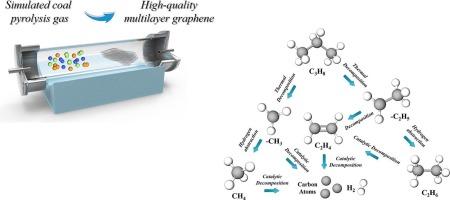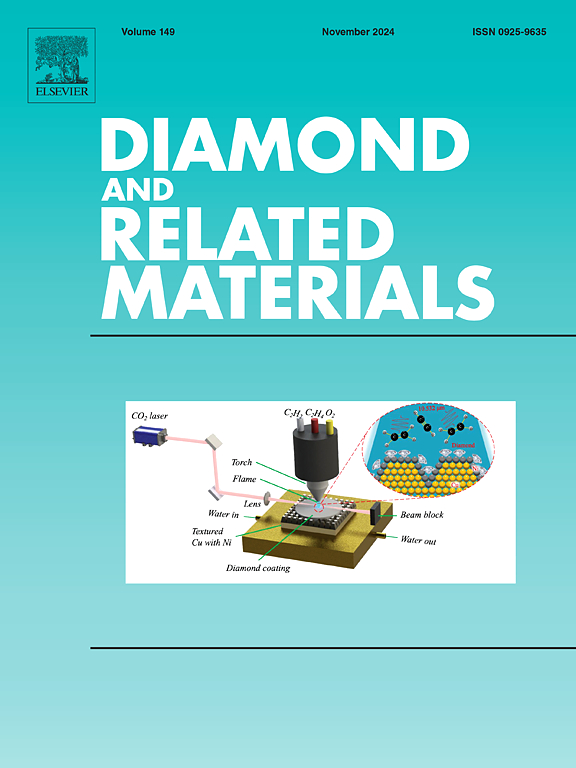Preparation and growth mechanism of high-quality multilayer graphene from simulated coal pyrolysis gas via chemical vapor deposition
IF 4.3
3区 材料科学
Q2 MATERIALS SCIENCE, COATINGS & FILMS
引用次数: 0
Abstract
Chemical vapor deposition (CVD) of graphene from coal pyrolysis gas provides new ways for both large-scale graphene preparation and high value-added utilization of coal. However, green, efficient and continuous preparation of high-quality multilayer graphene with both good uniformity and ideal structure characteristic remains a great challenge. Herein, we first investigated the influence of main carbonaceous species (CH4, C2H6, C3H8, CO2, and CO) in coal pyrolysis gas on the quality of CVD graphene products. The experimental results indicated that CO2 and CO have little effect on the growth of graphene, while methane as carbon source is conducive to obtain ideal graphene materials, propane and ethane could also influence structural defects and layer number of graphene products remarkably. On this basis, we designed a mixed gas of methane, ethane, and propane with optimized ratio as simulated coal pyrolysis gas, and successfully prepared high-quality multilayer graphene products on nickel foam from the as-designed simulated coal pyrolysis gas by CVD method. Notably, with a CH4:C2H6:C3H8 ratio of 2:1:1, the graphene products prepared from simulated coal pyrolysis gas outperformed that of raw coal pyrolysis gas in terms of physical structure, layer number, and quality uniformity. The corresponding I2D/IG value reached 0.97. The graphene growth process and mechanism were investigated and discussed macroscopically and microscopically. This work is of great significance for the intrinsic understanding of CVD growth of graphene from coal pyrolysis gas, and also inspires an efficient and environmentally friendly avenue for high-throughput, uniform production of high-quality graphene materials.

通过化学气相沉积从模拟煤热解气体中制备高质量多层石墨烯及其生长机理
以煤热解气为原料进行化学气相沉积(CVD)制备石墨烯,为大规模制备石墨烯和煤的高附加值利用提供了新途径。然而,如何绿色、高效、连续地制备具有良好均匀性和理想结构特征的高质量多层石墨烯仍然是一个巨大的挑战。在此,我们首先研究了煤热解气体中主要碳质(CH4、C2H6、C3H8、CO2 和 CO)对 CVD 石墨烯产品质量的影响。实验结果表明,二氧化碳和一氧化碳对石墨烯的生长影响不大,而甲烷作为碳源有利于获得理想的石墨烯材料,丙烷和乙烷对石墨烯产品的结构缺陷和层数也有明显影响。在此基础上,我们设计了优化比例的甲烷、乙烷和丙烷混合气体作为模拟煤热解气体,并利用 CVD 法在泡沫镍上成功制备了高质量的多层石墨烯产品。值得注意的是,当 CH4:C2H6:C3H8 的比例为 2:1:1 时,模拟煤热解气制备的石墨烯产品在物理结构、层数和质量均匀性方面均优于原煤热解气制备的石墨烯产品。相应的 I2D/IG 值达到了 0.97。对石墨烯的生长过程和机理进行了宏观和微观的研究和讨论。这项工作对于从煤热解气体中 CVD 生长石墨烯的本质理解具有重要意义,同时也为高通量、均匀生产高质量石墨烯材料提供了一条高效、环保的途径。
本文章由计算机程序翻译,如有差异,请以英文原文为准。
求助全文
约1分钟内获得全文
求助全文
来源期刊

Diamond and Related Materials
工程技术-材料科学:综合
CiteScore
6.00
自引率
14.60%
发文量
702
审稿时长
2.1 months
期刊介绍:
DRM is a leading international journal that publishes new fundamental and applied research on all forms of diamond, the integration of diamond with other advanced materials and development of technologies exploiting diamond. The synthesis, characterization and processing of single crystal diamond, polycrystalline films, nanodiamond powders and heterostructures with other advanced materials are encouraged topics for technical and review articles. In addition to diamond, the journal publishes manuscripts on the synthesis, characterization and application of other related materials including diamond-like carbons, carbon nanotubes, graphene, and boron and carbon nitrides. Articles are sought on the chemical functionalization of diamond and related materials as well as their use in electrochemistry, energy storage and conversion, chemical and biological sensing, imaging, thermal management, photonic and quantum applications, electron emission and electronic devices.
The International Conference on Diamond and Carbon Materials has evolved into the largest and most well attended forum in the field of diamond, providing a forum to showcase the latest results in the science and technology of diamond and other carbon materials such as carbon nanotubes, graphene, and diamond-like carbon. Run annually in association with Diamond and Related Materials the conference provides junior and established researchers the opportunity to exchange the latest results ranging from fundamental physical and chemical concepts to applied research focusing on the next generation carbon-based devices.
 求助内容:
求助内容: 应助结果提醒方式:
应助结果提醒方式:


